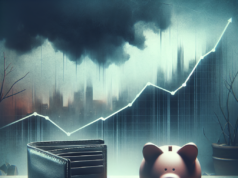In recent months, the business landscape has witnessed an alarming rise in bankruptcy filings, signaling a potential crisis that could reverberate throughout the economy. As companies across various sectors struggle to maintain financial stability, the surge in bankruptcies serves as a wake-up call for stakeholders at all levels. This article delves into the underlying causes of this trend, its implications for local communities, and potential strategies for businesses and policymakers to mitigate future risks.
Understanding the Recent Surge in Bankruptcy Filings Across Various Sectors
The recent surge in bankruptcy filings has been observed across a diverse array of sectors, including retail, hospitality, and manufacturing. According to data from the American Bankruptcy Institute, filings have increased by over 30% compared to the previous year, with small and medium-sized enterprises (SMEs) disproportionately affected. This trend is particularly concerning as many of these businesses serve as the backbone of local economies, providing jobs and essential services. The rise in bankruptcies is not confined to struggling startups; established companies are also facing financial distress, indicating a systemic issue that transcends individual business challenges.
Key Factors Contributing to the Unprecedented Increase in Business Failures
Several key factors have converged to create an environment ripe for business failures. The lingering effects of the COVID-19 pandemic, coupled with supply chain disruptions, have severely impacted operational capabilities. Additionally, rising costs of raw materials and labor have squeezed profit margins, forcing many businesses to make difficult decisions. The rapid shift towards digitalization and e-commerce has also left some traditional businesses struggling to adapt. Furthermore, a lack of access to affordable financing options has hindered recovery efforts, pushing many companies to the brink of insolvency.
The Economic Implications of Rising Bankruptcy Rates on Local Communities
The implications of rising bankruptcy rates extend far beyond the affected businesses themselves. Local communities face significant economic repercussions, including job losses and reduced consumer spending. When businesses close their doors, the ripple effect can lead to increased unemployment rates, diminished tax revenues, and a decline in local services. This can create a vicious cycle where the economic downturn further exacerbates financial instability, leading to additional business closures. Moreover, the loss of community staples can erode the social fabric, diminishing the quality of life for residents and creating an atmosphere of uncertainty.
Analyzing the Impact of Inflation and Interest Rates on Financial Stability
Inflation and rising interest rates have emerged as critical factors influencing the financial stability of businesses. As inflation continues to climb, the cost of goods and services has surged, putting additional pressure on companies to maintain competitive pricing while managing their expenses. Concurrently, the Federal Reserve’s decision to increase interest rates in an effort to combat inflation has made borrowing more expensive for businesses. This dual challenge has left many companies grappling with tighter margins and reduced cash flow, ultimately leading to a higher likelihood of bankruptcy. The interplay between these economic indicators underscores the fragility of the current business environment.
Strategies for Businesses to Navigate Economic Challenges and Avoid Bankruptcy
In light of the current economic climate, businesses must adopt proactive strategies to navigate challenges and avoid bankruptcy. Diversifying revenue streams can help mitigate risks associated with market fluctuations, while investing in technology and innovation can enhance operational efficiency. Additionally, maintaining a robust cash reserve can provide a buffer during lean times. Companies should also prioritize financial literacy and seek professional advice to better understand their financial health. By fostering a culture of adaptability and resilience, businesses can position themselves to weather economic storms and emerge stronger.
Policy Recommendations to Mitigate Future Bankruptcy Risks in the Economy
To address the rising tide of bankruptcies and foster a more resilient economy, policymakers must implement targeted interventions. Enhancing access to affordable financing for small businesses can provide the necessary capital for recovery and growth. Additionally, creating programs that support workforce development and retraining can help displaced workers transition to new opportunities. Policymakers should also consider tax incentives for businesses that invest in innovation and sustainability, which can drive long-term economic growth. Finally, establishing a comprehensive safety net for businesses facing financial distress can help prevent cascading failures and protect local economies.
The unprecedented surge in bankruptcy filings serves as a stark reminder of the vulnerabilities within our economic system. As businesses grapple with a myriad of challenges, it is imperative for stakeholders—ranging from business owners to policymakers—to collaborate in developing effective strategies that promote resilience and stability. By understanding the underlying factors contributing to this trend and implementing proactive measures, we can work towards a more robust economic future that minimizes the risks of bankruptcy and supports sustainable growth.





















